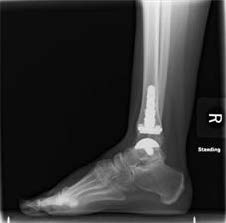Total ankle replacement, also known as total ankle arthroplasty, is a surgical procedure that foot and ankle orthopedic surgeons use to treat ankle arthritis. Arthritic changes may be a result of normal wear and tear due to aging or from an injury such as a broken ankle or dislocation. Arthritis eventually leads to loss of cartilage, pain, and/or deformity.
In this procedure, the ankle joint is removed and replaced with an artificial implant made of metal and plastic. The goal of ankle replacement is to provide pain relief while preserving ankle motion so the patient has less pain and better function during activity.
Diagnosis
If you have tried non-surgical treatment including anti-inflammatory medication, bracing, physical therapy, activity modification, and injections, and continue to experience ankle pain and decreased function from arthritis, your foot and ankle orthopedic surgeon may recommend ankle replacement.
Ankle replacement is not recommended if you have severe deformity, dead bone in the talus (the bottom bone of the ankle joint), or bone too soft to support the joint. A history of deep infections of the ankle, significantly abnormal nerve function or sensation (also known as peripheral neuropathy), inadequate or absent leg muscle function, and poor blood flow of the leg also are signs that ankle replacement should be avoided. In these cases, an ankle fusion may be a better option for pain relief.

Post-surgery x-ray of a total ankle replacement
Treatment
Ankle replacement is performed either under general anesthesia or nerve block. Your surgeon will use a tourniquet to control bleeding and improve visualization during the surgery. They will approach the ankle from the front or the side, depending on the type of implant being used. They then cut the bone and place the metal and plastic components that recreate the ankle joint. Sometimes additional procedures will have to be done at the same time to ensure the foot and ankle are properly aligned and the deformity is corrected. Your surgeon then closes the wounds using stitches or staples, and applies a splint.
Recovery
Recovery from a total ankle replacement requires a variable period of non-weightbearing in a cast or boot to allow the implants to heal in place. The procedure is usually performed in an inpatient setting, with the patient spending up to several nights in the hospital. Strict elevation for many days after the procedure is necessary to control swelling and improve wound healing. After the surgical wounds are healed, some foot and ankle orthopedic surgeons will allow the patient to start working on gentle range-of-motion activities even if they are non-weightbearing. Weightbearing usually begins a few weeks after surgery if X-rays show good healing.
Risks and Complications
All surgeries come with possible complications, including the risks associated with anesthesia, infection, damage to nerves and blood vessels, and bleeding or blood clots. A broken bone on the side of the total ankle implant is the most common complication. Patients may also experience an injury to the tendons, nerves, or blood vessels. Wound healing is critical in the early weeks as issues with wound healing can lead to superficial or deep infections. Many of these problems are a greater risk in patients who smoke, have diabetes, or have rheumatoid arthritis. Another possible complication is the failure of the ankle implant to heal into the bone.
Just as with artificial knee and hip replacements, ankle replacements may have problems that happen even years after the initial surgery because there are moving, artificial parts. These issues may require additional surgery and include infection or loosening/wear of the artificial parts.
FAQs
There are two surgical approaches for treatment of end-stage ankle arthritis: ankle fusion and total ankle replacement. Why should I consider an ankle replacement?
There are many factors that go into this decision, so each individual case should be discussed with your foot and ankle orthopedic surgeon. In general, when motion of the ankle is preserved in an ankle replacement, the surrounding joints are protected from increased wear, which is especially important if there is already arthritis in these neighboring joints. The number of ankle replacements being performed is increasing dramatically, as is the amount of published and ongoing research in the area. Newer implant designs and improved surgical techniques constantly are evolving with the promise and goal of helping patients with an ankle replacement get results at least as good as their hip and knee counterparts.
Who should I see to have a total ankle replacement?
A foot and ankle orthopedic surgeon should be seen for management of ankle arthritis. Orthopedic surgeons who specialize in foot and ankle surgery are specifically trained to perform ankle replacements as well as take care of any complications that may arise.

